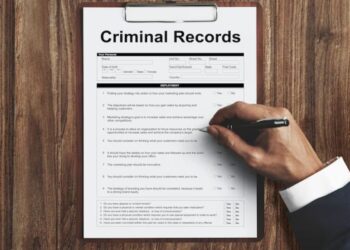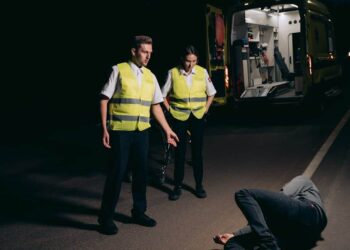The chaotic moments following a motor vehicle collision can be overwhelming, yet the actions taken immediately after the incident are crucial for protecting your legal rights.
In Massachusetts, where over 125,000 motor vehicle crashes were reported in 2023, comprehensive preparation isn’t just wise; it’s essential.
Critical evidence at the scene—such as the final position of vehicles, tire marks, and debris—disappears quickly. Following a methodical documentation process, you systematically preserve the vital evidence necessary to substantiate your claim and secure fair compensation.
Immediate Priorities: Safety and Official Reporting
Your first concern must be the health and safety of everyone involved. An accident scene is inherently hazardous, and taking the correct initial steps prevents further harm while establishing the foundation for your legal claim.
Safety First
- Check for Injuries: Immediately assess yourself and your passengers for injuries. Adrenaline often masks pain, so a thorough check is vital. If anyone is hurt, call 911 immediately. Take care to not move injured individuals unless they are in immediate or imminent danger, such as from fire or oncoming traffic. Follow the dispatcher’s instructions until emergency medical services arrive.
- Move to a Safe Location: If the accident is considered minor and the vehicles involved are drivable, carefully move them to the shoulder or a nearby safe spot, like a parking lot. If the cars cannot be moved, activate your hazard lights immediately to warn approaching drivers.
- Preserve the Scene (If Possible): Unless necessary for safety, it’s critical to leave the vehicles and surrounding debris undisturbed until the police arrive. The initial positions of the cars, skid marks, and location of debris are crucial physical evidence used by accident reconstruction experts to determine factors like speed and the point of impact. Disturbing the scene can inadvertently destroy this proof, making it harder to establish fault.
Call the Police and Control Your Statements
- Call the Police: Always report the accident, regardless of how minor it seems. A formal police report is a powerful, third-party account that includes diagrams, party information, and the officer’s initial observations. This official documentation is critical, especially since Massachusetts recorded 346 traffic fatalities in 2023.
- Cooperate but Do Not Admit Fault: When speaking with the police or other drivers, state only the objective facts of what happened (e.g., I was traveling north on Main Street). Describe your direction and the sequence of events without emotion or speculation. Never apologize or admit fault, even indirectly (e.g., I’m so sorry). Such impulsive statements could be interpreted as an admission of guilt and used against you by insurance companies, regardless of what the investigation later proves.
Creating a Comprehensive Visual Record
In modern claims and litigation, photographic and video evidence is often the most compelling proof. Your smartphone, especially with new advanced functions, is a powerful tool for capturing a detailed, timestamped record of the accident scene that can refute false claims.
The Photo Checklist
Systematically capturing the scene ensures no vital detail is missed:
- Start with the Big Picture: Take wide-angle photos and videos from all four corners of the intersection or the road section. Capture the entire scene, including all vehicles in their final resting positions and any relevant traffic signs, signals, or significant landmarks. This overarching view provides crucial context for accident reconstruction efforts.
- Document Vehicle Damage: Move closer to document the damage to every vehicle involved, not just your own. Take multiple close-up shots of every dent, scratch, and broken part from various angles. If airbags are deployed, photograph them, as this evidences the force of the impact. Be sure to photograph the license plates and the other vehicle’s Vehicle Identification Number (VIN), usually visible through the windshield.
- Capture Environmental Factors: Photograph evidence on the road surface, such as skid marks, gouges in the pavement, and scattered debris. Capture images of contributing environmental factors like obscured traffic signs, rain-slicked roads, or heavy sun glare that may have impaired a driver’s visibility.
- Photograph Injuries: Take clear, well-lit photos of any visible physical injuries sustained by you or your passengers, including cuts, bruises, abrasions, or swelling. These images serve as immediate, timestamped evidence of the physical harm caused by the crash.
Collecting Essential Data and Personal Accounts
Visual evidence must be supplemented with concrete information from people and the environment.
Data Exchange and Witness Identification
- Exchange Driver Information: Remain calm and professional while exchanging details with the other driver(s). Secure the following:
- Full name, home address, and phone number.
- Driver’s license number.
- Insurance company name and policy number.
- The most accurate way to do this is to take clear photographs of their driver’s license and insurance card.
- Identify Witnesses: Independent witnesses are highly valuable assets because their testimony is unbiased. If anyone saw the accident, politely ask for their full name and contact information (phone number and email). Do not pressure them for an immediate, detailed statement; secure a way to contact them later. Note any nearby businesses, homes, or traffic poles with a surveillance camera that could have recorded the incident.
Record Your Narrative
Because memory fades quickly after a traumatic event, record your detailed narrative as soon as you have a quiet moment. Use your phone’s voice recorder or notes app to document the date, exact time, and location. Describe in detail the critical moments leading up to the crash, the sequence of events as you remember them, and any statements made by the other driver or witnesses at the scene. This personal account is an invaluable resource for you and your attorney.
From Documentation to Legal Claim
The evidence you meticulously collect forms the foundation of a strong insurance claim and any potential legal action. Meticulous documentation prevents the at-fault party from altering their story and provides tangible proof of liability and the extent of your damages.
While gathering evidence at the scene is the first crucial step, interpreting it and building a compelling legal argument requires professional expertise. An experienced US personal injury attorney can leverage your photos, witness statements, and police reports into a successful legal strategy, navigating complex insurance negotiations and liability disputes. To fully understand how your evidence fits into the legal landscape and your rights after an accident, the next step is to educate yourself on the state’s laws. A comprehensive Massachusetts Personal Injury Law Guide can provide a foundational understanding of the claims process, from dealing with no-fault insurance to knowing the statute of limitations. This resource ensures you’re well-informed and protected.
The diligent work you perform in the first half-hour following a crash can prevent months or years of financial hardship and legal difficulties that arise from an unsubstantiated case. Your preparation empowers you to secure the compensation you deserve.










